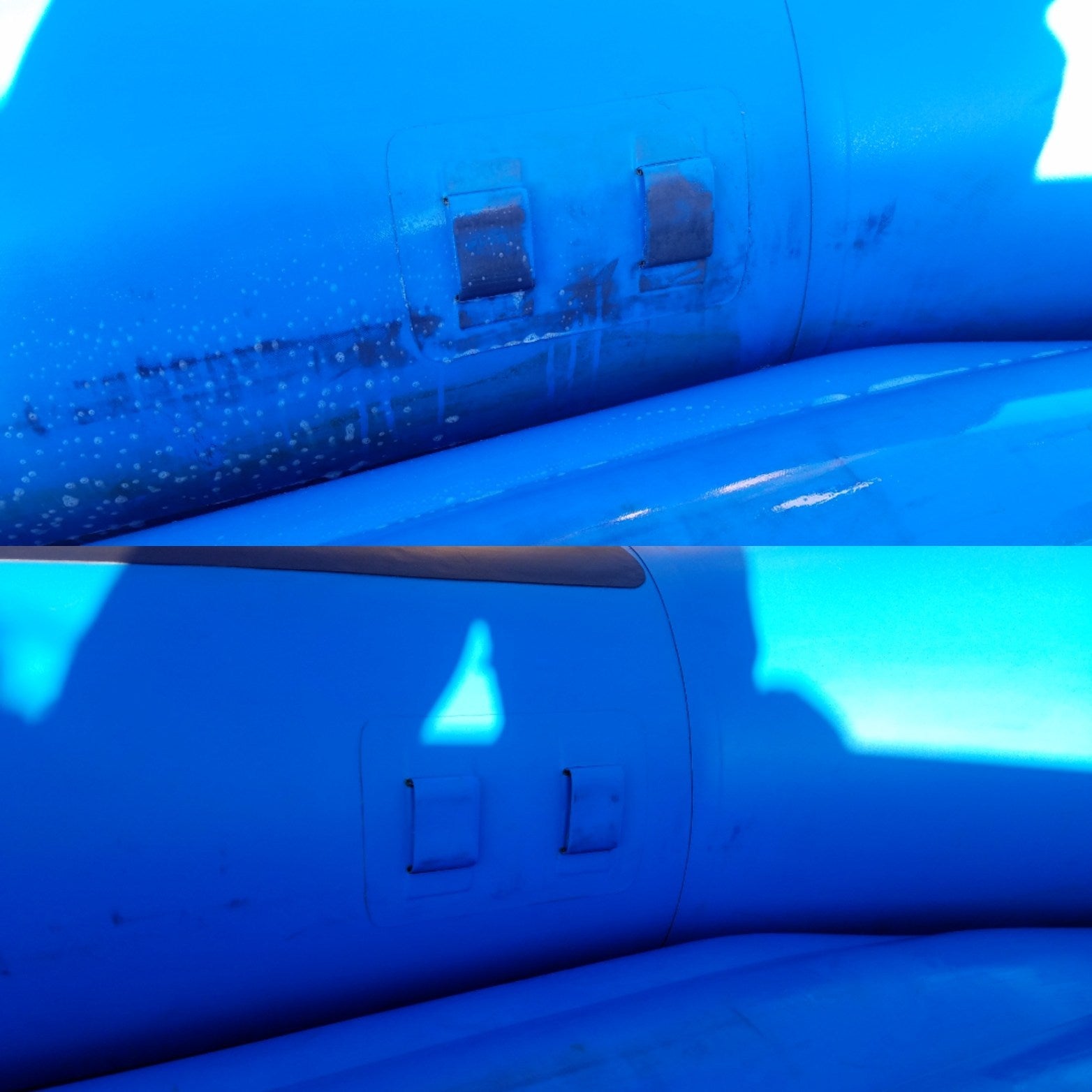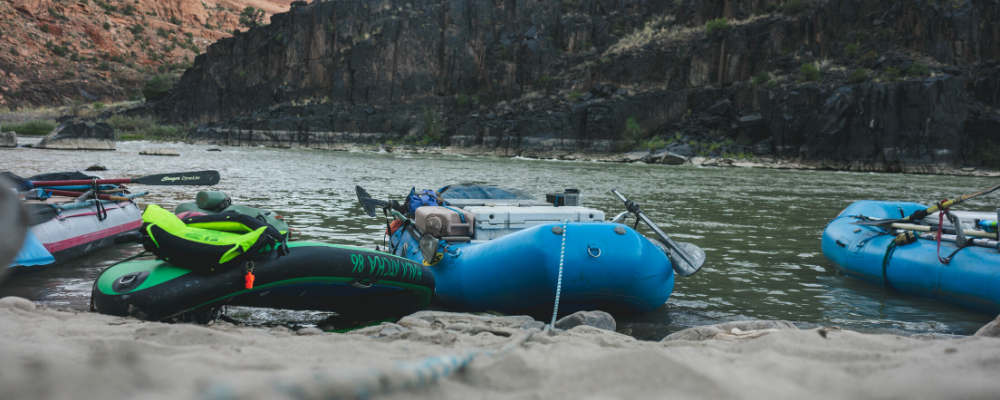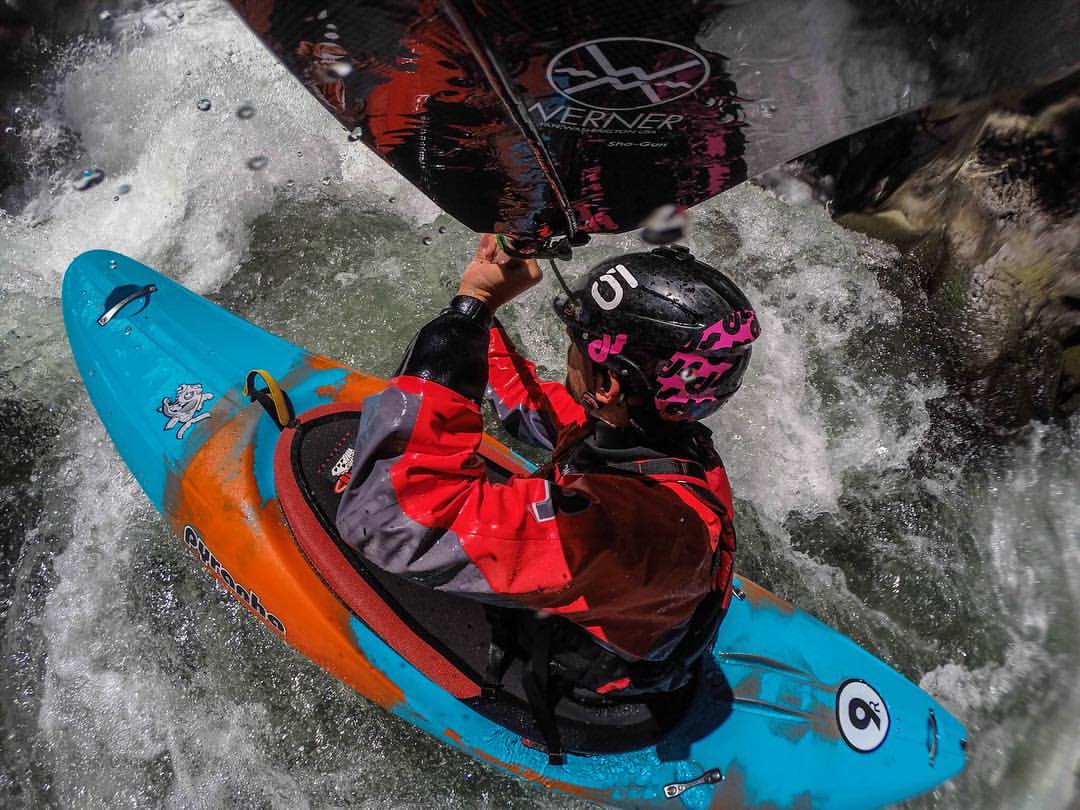Boating season is here! As you're pulling the trailer out of the garage, it’s hard not to notice the stains on your boats from all the days of fun on the water you've been having. You never knew a boat could get so dirty... after all: it's in water, constantly getting washed off, right? It’s not until you brush up against the boat with a white T-shirt on that you notice how bad it’s getting. It’s time to give it some love!
An inflatable boat should be cleaned and treated with the appropriate products to ensure that it lasts as long as possible. There are two things you’ll need to buy if you don’t already have them: NRS Inflatable Boat Cleaner and 303 Aerospace Protectant. You’ll also need to procure a ton of clean rags, as you’ll be scrubbing every inch of the boat by hand.
If you don’t have a garage, you’ll need to be selective when it comes to the weather outside when you choose to clean your boat. An overcast day is ideal, as the sun won’t evaporate the boat cleaner before it’s worked its magic on the stains and grime on your tubes. If it’s later in the year and you’re dealing with frosty mornings, wait until it's about 50 degrees out so.

Step 1: Prewash
Before you get to work on cleaning your boat by hand, do yourself a favor and head over to a do-it-yourself carwash (or use a hose if you have one) and spray any obvious mud and dirt off the boat. If you are using a power washer at a carwash, don’t get too close with the pressurized water, as it can damage your seams or blast dirt into them. Spray down in the bail scuppers and pull out any leaves, sticks, and cam straps that have been hiding for months in there. If heading over to a carwash is not an option, check out the If you run your boat with a frame all summer, it’s amazing what you find down there…
Step 2: Elbow Grease
Now comes the FUN part - scrubbing the boat clean with Boat Cleaner. You’ll probably want to grab a few beverages and some good music because this part is tedious and takes a while.
A few considerations before you get going: NRS recommends wearing gloves when you use boat cleaner. I do not and my hands suffer for sure. Despite being biodegradable, this is a very strong cleaner and exposing your hands to it for a while is probably not great for your skin. I’ve noticed the skin at the end of my fingers peeling after about an hour of use. Use bare hands at your own risk… I also recommend grabbing a spare spray bottle and mixing the cleaner 50-50 with water. It works just as well at half strength and saves your hands a bit.
You don’t want to apply cleaner to the whole surface of the boat at once or it will evaporate or dry before you can wipe it off. Instead, you want to work section-by-section. I use the seam boundaries to define each section. Spray an even coating of cleaner on each section you are working on, let it sit for about a minute, then scrub it off with a rag. It’s amazing how well this stuff works. For most stains, one wipe and is all you need. For stubborn stains, reapply several times. This stuff works equally well on river grime and metal wear from your frame and drybox.

My Eddy Out Drybox fits pretty snugly in my NRS Otter 130. Both the floor and thwart-batten patch gets quite a bit of aluminum rubbing off on them. The above photo is from one round of half-strength cleaner. I went back after taking this photo and applied full-strength cleaner and let it sit for about five minutes. I scrubbed again and got all but the most stubborn marks off. With a Hypalon boat, you can pretty much get it looking new again with a little work.
Some important areas to pay attention to are seam boundaries and your bail scuppers. Seam boundaries can get dirt and grime in them and get weakened. It’s also a place that can get missed as you wipe if you are wiping in the direction of the overlap. Keeping your seams clean reduced the possibility of air leaks down the road. Bail scuppers (the holes in the bottom of the boat) tend to get real grimy too. They are always sitting in the water and all the algae, silt, and anything you spill in the boat ends up here. There is a lot of overlapping material as the bail scuppers are part of the material that bridges the gap between the inflatable floor and the outer tubes on most boats and there are a lot of nooks and crannies for grit to build up. Do the best you can to clean out this area as thoroughly as possible, as there are a lot of seam boundaries here. You’ll go through quite a few rags in this endeavor.
If you have a boat that has a laced-in floor (like AIRE rafts) rather than a welded floor, it may be easier to untie the rope that holds the floor in, pull the floor out of the boat and clean each piece individually. It is up to you if you want to go that far.

Don’t forget about cleaning the bottom side of the boat. Once you’re done with the top, flip the raft over and do the bottom side of the tubes and floor. You’ll end up overlapping areas you already cleaned when you were scrubbing the top. This is a good chance to inspect your tubes and seam boundaries and note any places that have gotten wear and tear over the season, as well as noting placing where repairs might need to be made. Most people don’t take a look at the bottom of their boat very often and having a good pulse on how things are doing under there is important for keeping your boat going as long as possible.
Step 3: Rinse
Did you like wiping every square inch of the boat in the last step? Good! You’re gonna do it again now with a wet rag. The goal here is to get the remaining boat cleaner and additional grime off before we treat the boat in the last step. While the boat cleaner gets the majority of the visible grime off the boat in the first round of wiping, you’ll be surprised how dirty the rags get when you go back over everything. Make sure to save a few clean rags for this step, so you aren’t wiping dirt back onto the boat.
You’ll notice faint drip marks where the boat cleaner inevitably dripped around the tubes while you were working with it. Make sure to scrub these off and inspect your boat closely to make sure you got it all. Take some time on this step, as this will affect the effectiveness of 303, which we will apply in the next step. You will know you are done when you can wipe a damp rag anywhere on the boat and the surface no longer appears soapy. Then, let the boat fully dry.
Step 4: 303 Aerospace Protectant
Now that you’ve got your boat all cleaned up, there is one final step; application of 303. Never apply 303 without cleaning the boat first - it must be applied to clean material. This product is important for maintaining the material your boat is made out of, and protecting it from the sun. Radiation from the sun will eventually fade and degrade all vinyl and rubber materials, given enough time and exposure. This is why it’s recommended that you store your boat in the shade, or in a garage/storage unit.
An important note before continuing: you need to know what your boat is made out of before using 303. There are generally two materials that are used for inflatable boat construction. The first, and most widely available is Polyvinyl-chloride, better known as PVC. The second is synthetic rubber, commonly known under the trade names Hypalon or Pennel-Orca. 303 Aerospace protectant is a double-edged sword when it comes to use with PVC boats. While it’s important to protect your boat from the sun to extend its life as long as possible, the plasticizers that make PVC a flexible material can be damaged by 303 if it is over-applied or applied too frequently. This, generally speaking, is why PVC boats don’t last as long as Hypalon boats. Conversely, Hypalon can practically be bathed in 303 with no detriment to the material.
Applying 303 is pretty straightforward. WIth the spray bottle in one hand and a clean rag in the other, spray 303 directly onto the material and wipe it around until it has a nice shine. Watch your overspray, and make sure to wipe up excess 303 if it pools. With a PVC boat, one coat is adequate. With a Hypalon boat, I apply several rounds of 303 since there is no reason not to and doing so helps ensure that you didn’t miss any spots.

When you’re done, the result is really satisfying! The AIRE Sabertooth (purple cat on top) is made of PVC and has one coat of 303, the NRS Otter 130 (blue boat on bottom) is made of Pennel-Orca (Hypalon) and has several coats. The top picture was taken before any cleaning had started after a very muddy trip down the trough road near Kremmling, CO. The bottom photo was taken after we were all done with both boats. Between both crafts and two people working, it took us about 4 hours to complete both boats. Both of these boats see about 50 days on the river every year and get used as both paddle rafts and oar rigs often. The Otter is 3 seasons old and the Sabertooth is 2. As you can see, cleaning and solar-proofing make the boats look essentially brand new!
How often should you clean?
It depends on how often you use your boat. A good practice for all boat types is to do it once per season. If you really put a Hypalon boat through the wringer, it’s appropriate to do this several times a season. Even with heavy use, a Hypalon boat like the Otter can easily last over 20 years with few problems if stored properly, cleaned often, and treated semi-annually with 303. A PVC boat should be cleaned with cleaner less frequently, as Boat Cleaner removes the protective layer of 303, and reapplying 303 can damage your boat material if done too frequently. A boat like the AIRE pictured will last about 15 years on average if cleaned and treated each year. If your PVC boat is getting really dirty and you already applied 303 this year, just use rags and water to scrub the grime off.
One final caveat - when you apply 303 to any boat, it will make the tubes a bit slippery. If you’re coming into high water season and you are using your boat as a paddle raft often, you might forgo 303 until the water comes down or you will have quite a few more swimmers than normal, as your crew will be more likely to slide off the boat when you hit a wave or a hole.
So, there you have it, a full how-to for taking care of your boat! Now you have no excuse not to take care of your investment! See you on the river - with your clean shiny boat!

Written By Jake Castle, our GearSpace store manager. Photos By Amanda Castle, his esteemed Wife.




